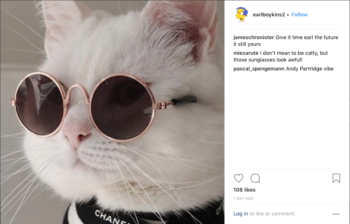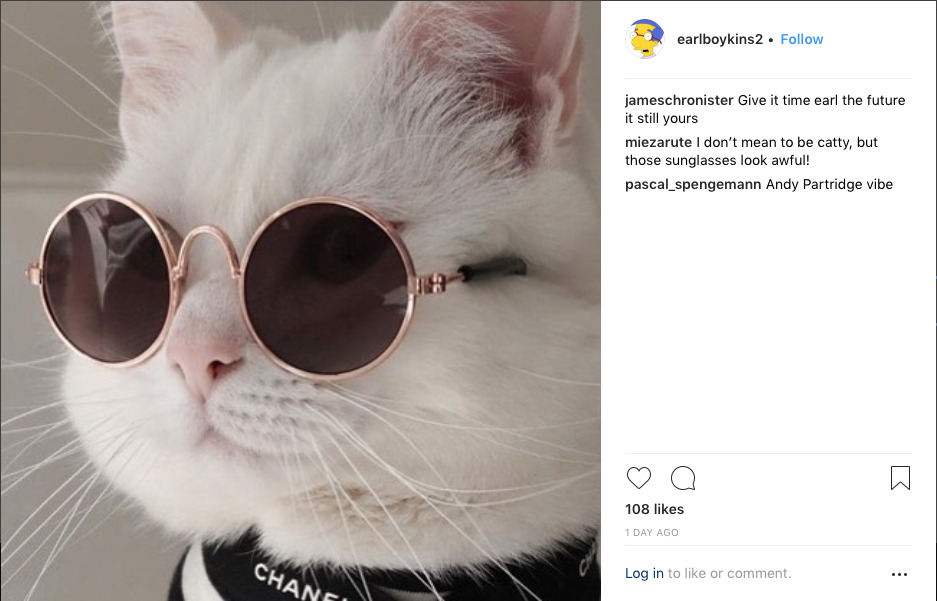[ad_1]

Screenshot from @earlboykins2 Instagram account.
For the past half-decade or so, the Instagram account @earlboykins, run by the artist and illustrator Andrew Kuo, has provided a reliable stream of visual non-sequiturs, powered by the endless flow of the internet—everything from confused small animals to the absurdist runoff of various forms of popular culture. Last week, the account was removed by Instagram. Shortly after, Kuo started over, under the handle @earlboykins2. (There is now also a third account—@earlboykins3—that was created by a daughter of a friend of Kuo.)
“First of all, I’m not mad about this at all, [Instagram] makes their terms and conditions very clear,” Kuo told me over the phone recently. The artist operates his account under very specific conceptual guidelines: no photos from friends, no captions, no credits. This can lead to confusion regarding authorship—and, potentially, complaints about his lack of attributions. “I think you just reach a quota of people complaining and then they remove your site,” Kuo said.
Shortly after receiving the news, Kuo—who’s had solo shows at Marlborough Contemporary in New York and the Green Gallery in Milwaukee—decided to open a sequel account. “At first I didn’t really have a feeling about it any which way, but then I decided, like, the least dramatic thing I could do—or not dramatic, dramatic’s the wrong word—the easiest thing I could do is just start up another one,” he said.
The 2.0 version of @earlboykins picks up exactly where the first account left off. A quick glance at Kuo’s recent activity shows a photo of a frown-face emoji shaved into the back of a person’s head next to a trompe-l’œil-like picture of a black cat whose positioning on top of an air conditioner—orb-like body, only two legs visible—puts it into an uncanny valley territory between feline and something more mysterious. “I’m still interested in great internet photos,” Kuo said.
That interest has led to him sharing a large log of content over the years. I wondered how much time the artist spent on the project each day. “It’s pretty subjective,” he said. “I’m sure a lot to somebody and not a lot to others. If you ask me, not much time. I spend a ton of time in the studio waiting for paints and gel mediums to dry.” He typically culls photos not from other meme sites, or Instagram, or Reddit, but something far more simple: Google. “I always joke, as soon as someone finds out that I’m behind that account, everything is disappointing,” Kuo said. “It’s just Google. I just Google something I’m thinking of and hours disappear.”
On the internet, ownership is often a contested issue, and the very act of discovering an image can give the finder a sense of agency and possession. Kuo has a refreshing level of perspective when it comes to this discussion. “I have seen bigger accounts kind of mirror my account at times, and I absolutely love it,” he said. As for his own account, Kuo said that he has a consistent approach when people complain to him directly. “My vibe is always the same—these are wonderful photos, and judging by the photos, these people are probably wonderful people, and I’ll just take it down,” he said.
All of which is to say that Kuo is comfortable about his position within the larger, endless garbage stream that is the internet. “I am totally insignificant,” he continued. “I’m just like a phone cable, kind of. And it’s an enjoyable conversation, but I am just a telephone wire for whatever you think a meme is.”
“I’m going to keep on going,” Kuo said. “It’s just as enjoyable. It’s hard to describe, but nothing has really changed. I lost a ton of followers, but that’s OK. Those numbers don’t mean much if you think about it.”
[ad_2]
Source link

